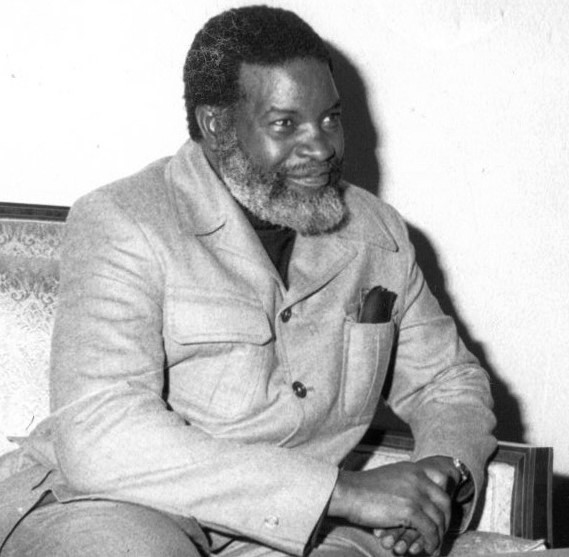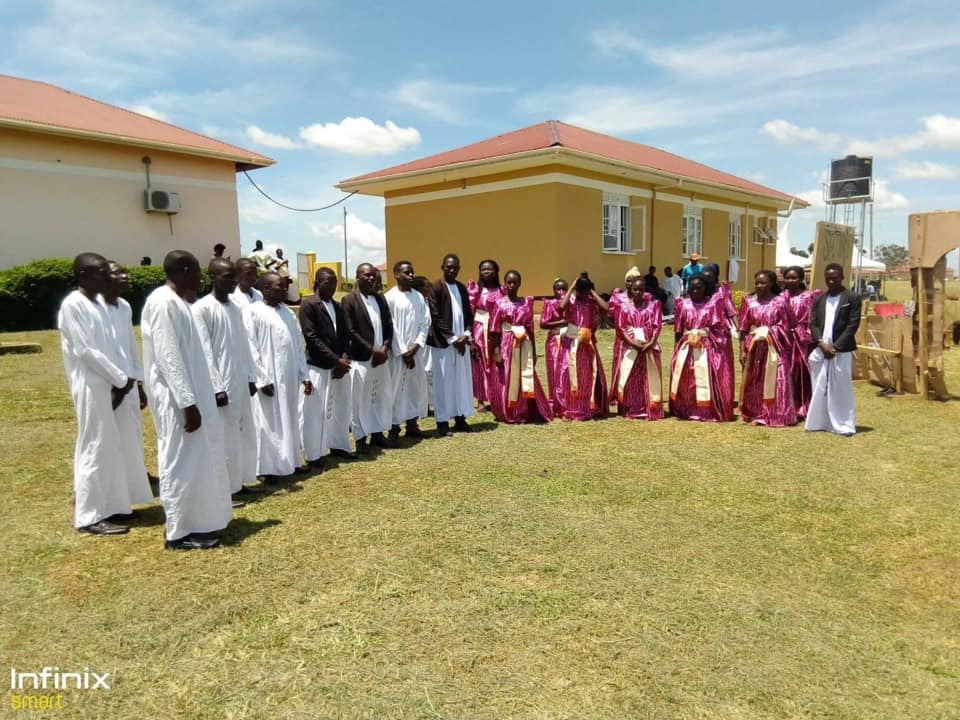|
Uukwambi
Uukwambi is a traditional kingdom of the Ovambo people in what is today northern Namibia. Its capital is Elim. The last king of Uukwambi was Iipumbu yaTshirongo, who was toppled by the South African authorities in 1932. Nowadays the highest traditional authority in Uukwambi is referred to as ‘head chief’ (‘elenga enene’). Using the prefix uu- (Bantu noun class 14) to refer to the land belonging to the tribe sets the Kwambis apart from their neighbours the Ndongas and the Ngandjeras, who use the noun class 9 prefix instead (Ondonga and Ongandjera, respectively). This practice is however by no means unique to the Kwambis but is also found in some other parts of Bantu-speaking Africa. Compare for example ‘Uganda’, which signifies the land of the Ganda people, in the same way that ‘Uukwambi’ signifies the land of the Kwambi people. The most important town of northern Namibia, Oshakati ( Kwambi: Otshakati), is located within the traditional borders of Uukwambi. Sam ... [...More Info...] [...Related Items...] OR: [Wikipedia] [Google] [Baidu] |
Iipumbu Ya Tshilongo
Iipumbu ya Tshilongo (1875–1959) was king of the Uukwambi, an Ovambo clan in Namibia, from 1907 to 1932. He is one of the national heroes of Namibia. Biography Iipumbu ya Tshilongo was born in 1873 in Onatshiku, a settlement near Elim, today in the Omusati Region of northern Namibia. An accident as adolescent earned him the nickname ''Ndilimani'' (Oshiwambo: ''dynamite'') when an explosion blew three fingers off his left hand. He became the eighteenth king of the Uukwambi in 1907, succeeding king Negumbo lya Kandenge. During his reign he became known to jealously protect the tribal area of the Uukwambi from encroaching white settlers, going as far as having the roads guarded that led into Uukwambi territory. Ya Tshilongo also resisted European cultural influence exercised via the establishment of mission stations and administrative outposts. Having rebuked the Finnish Missionary Society and the South West African Administration for years, he only allowed the Catholic Church to ... [...More Info...] [...Related Items...] OR: [Wikipedia] [Google] [Baidu] |
Elim, Namibia
Elim is a village in the north-east of the Republic of Namibia. It is the district capital of the Elim Constituency in the administrative Omusati Region. It is situated in a formerly forested area that has largely been converted into agricultural grassland. Elim is the centre of the Uukwambi traditional authority. The ''Monument for the Uukwambi Kings'', erected at the site of the grave and the remains of the homestead of king Nuuyoma, the sixteenth king of the Uukwambi, is situated here. History Elim was founded as a Finnish missionary station on 18 July 1870. Gradually, administration of the Lutheran parishes in Ovamboland was transferred from the Finnish missionaries to native ministers. Elim was one of eight such parishes and as such an important site of the Evangelical Lutheran Church in Namibia. It has a well-developed infrastructure, including a clinic, church, constituency head office, community hall, mobile antenna, its own water supply, several shebeens, a 'China s ... [...More Info...] [...Related Items...] OR: [Wikipedia] [Google] [Baidu] |
Ovambo People
The Ovambo people (), also called Aawambo, Ambo, Aawambo (Ndonga, Nghandjera, Kwambi, Kwaluudhi, Kolonghadhi, Mbalantu), or Ovawambo (Kwanyama) the biggest of the Aawambo sub-tribes are a Bantu ethnic group native to Southern Africa, primarily modern Namibia. They are the single largest ethnic group in Namibia, accounting for about half of the populationNamibia: People and Society CIA Factbook, United States; "about 50% of the population belong to the Ovambo tribe", total population: 2.4 million and one of Namibia’s most vibrant tribes. They have retained many aspects of their cultural practices, despite concerted efforts from Christian missionaries to wipe out what was believed to be ‘pagan practices’. They are also found in southern |
Sam Nujoma
Samuel Shafiishuna Daniel Nujoma, (; born 12 May 1929) is a Namibian revolutionary, anti-apartheid activist and politician who served three terms as the first President of Namibia, from 1990 to 2005. Nujoma was a founding member and the first president of the South West Africa People's Organization (SWAPO) in 1960. Prior to 1960, SWAPO was known as the Ovambo People's Organisation (OPO). He played an important role as leader of the national liberation movement in campaigning for Namibia's political independence from South African rule. He established the People's Liberation Army of Namibia (PLAN) in 1962 and launched a guerrilla war against the apartheid government of South Africa in August 1966 at Omungulugwombashe, beginning after the United Nations withdrew the mandate for South Africa to govern the territory. Nujoma led SWAPO during the lengthy Namibian War of Independence, which lasted from 1966 to 1989. During World War I, South Africa defeated the German colonial forces ... [...More Info...] [...Related Items...] OR: [Wikipedia] [Google] [Baidu] |
Helvi Mpingana Kondombolo
Samuel Shafiishuna Daniel Nujoma, (; born 12 May 1929) is a Namibian revolutionary, anti-apartheid activist and politician who served three terms as the first President of Namibia, from 1990 to 2005. Nujoma was a founding member and the first president of the South West Africa People's Organization (SWAPO) in 1960. Prior to 1960, SWAPO was known as the Ovambo People's Organisation (OPO). He played an important role as leader of the national liberation movement in campaigning for Namibia's political independence from South African rule. He established the People's Liberation Army of Namibia (PLAN) in 1962 and launched a guerrilla war against the apartheid government of South Africa in August 1966 at Omungulugwombashe, beginning after the United Nations withdrew the mandate for South Africa to govern the territory. Nujoma led SWAPO during the lengthy Namibian War of Independence, which lasted from 1966 to 1989. During World War I, South Africa defeated the German colonial forces ... [...More Info...] [...Related Items...] OR: [Wikipedia] [Google] [Baidu] |
Namibia
Namibia (, ), officially the Republic of Namibia, is a country in Southern Africa. Its western border is the Atlantic Ocean. It shares land borders with Zambia and Angola to the north, Botswana to the east and South Africa to the south and east. Although Kazungula, it does not border Zimbabwe, less than 200 metres (660 feet) of the Botswanan right bank of the Zambezi, Zambezi River separates the two countries. Namibia gained independence from South Africa on 21 March 1990, following the Namibian War of Independence. Its capital and largest city is Windhoek. Namibia is a member state of the United Nations (UN), the Southern African Development Community (SADC), the African Union (AU) and the Commonwealth of Nations. The driest country in sub-Saharan Africa, Namibia has been inhabited since pre-historic times by the San people, San, Damara people, Damara and Nama people. Around the 14th century, immigration, immigrating Bantu peoples arrived as part of the Bantu expansion. Since ... [...More Info...] [...Related Items...] OR: [Wikipedia] [Google] [Baidu] |
Baganda
The Ganda people, or Baganda (endonym: ''Baganda''; singular ''Muganda''), are a Bantu ethnic group native to Buganda, a subnational kingdom within Uganda. Traditionally composed of 52 clans (although since a 1993 survey, only 46 are officially recognised), the Baganda are the largest people of the bantu ethnic group in Uganda, comprising 16.5 percent of the population at the time of the 2014 census. Sometimes described as "The King's Men" because of the importance of the king, or Kabaka, in their society, the Ganda number an estimated 5.56 million in Uganda. In addition, there is a significant diaspora abroad, with organised communities in Canada, South Africa, Sweden, the United Kingdom, and the United States. Traditionally, they speak Luganda. History Early history The early history of the Ganda is unclear, with various conflicting traditions as to their origins. One tradition holds that they are descendants of the legendary figure of Kintu, the first human accordi ... [...More Info...] [...Related Items...] OR: [Wikipedia] [Google] [Baidu] |
Oshakati
Oshakati is a town in northern Namibia. It is the regional capital of the Oshana Region and one of Namibia's largest places. Oshakati was founded in July 1966 and proclaimed a town in 1992. The town was used as a base of operations by the South African Defence Force (SADF) during the South African Border War. History In Oshiwambo, the language of the Ovambo people, the town's name means "that which is in between", although some believe that the name (Oshakati, also Otshakati) was used to refer to the broadcasting tower ( high), the tallest structure in the town centre and in Namibia. On 19 February 1988, a bomb blast occurred in Oshakati at the First National Bank, killing 27 people and badly injuring nearly 30 others, most of them nurses and teachers. No one was ever convicted of the bombing and the issue was dropped upon independence in 1990 in favour of national reconciliation. Economy and infrastructure Oshakati has experienced much development since Namibia achie ... [...More Info...] [...Related Items...] OR: [Wikipedia] [Google] [Baidu] |
Kwambi Dialect
Kwambi or ''Otshikwambi'' is a dialect of the Ovambo language spoken by the Kwambi tribe in Northern Namibia. Unlike Ndonga Ndonga, also called Oshindonga, is a Bantu dialect spoken in Namibia and parts of Angola. It is a standardized dialect of the Ovambo language, and is mutually intelligible with Kwanyama, the other Ovambo dialect with a standard written form. Wi ... and Kwanyama it does not have a standardized written form in schools but is used and written in the Roman Catholic Church in Namibia. It shares more features with Ndonga than with Kwanyama. Phonology Vowels Kwambi uses a five-vowel system: Consonants Kwambi contains the following consonant phonemes: Note that the symbol ɾ has been chosen for the liquid phoneme in the table even though this phoneme has a wide range of pronunciations even in the speech of individual speakers, just like in Ndonga, ranging from an alveolar tap �to a lateral approximant with something that can perhaps be described as a l ... [...More Info...] [...Related Items...] OR: [Wikipedia] [Google] [Baidu] |
History Of Namibia
The history of Namibia has passed through several distinct stages from being colony, colonised in the late nineteenth century to Namibia's independence on 21 March 1990. From 1884, Namibia was a German colony: German South West Africa. After the First World War, the League of Nations gave South Africa a League of Nations Mandate, mandate to administer the territory. Following World War II, the League of Nations was dissolved in April 1946 and its successor, the United Nations, instituted a United Nations Trust Territory, trusteeship system to reform the administration of the former League of Nations mandates and clearly establish majority rule and independence as eventual goals for the trust territories. South Africa objected arguing that a majority of the territory's people were content with South West Africa#Bantustans, South African rule. Legal argument ensued over the course of the next twenty years until, in October 1966, the UNGA, UN General Assembly decided to end the mand ... [...More Info...] [...Related Items...] OR: [Wikipedia] [Google] [Baidu] |


_Muzej_Sam_Nujoma.jpg)


